

| Backpacking in Jamaica; what does it cost? | |
Kingston (Jamaica), March 4th 2015
|
|
|
|
|
Swaying palm trees, paradise beaches and a vibrant nightlife culture; Jamaica seems at first sight a true backpacker's paradise. However, in reality you see only a few backpackers here and the main reason is the high price. A flight to Jamaica is not cheap and there is the image that once you're on the island that you're traveling in third world circumstances for a first world price. Nevertheless, the island is not as expensive as the Lonely Planet (for many backpackers travel guide where they trust) will tell you. They estimated the daily cost at US$ 100 (EUR 89) per person per day, if you share a double room with someone else. Fortunately, this estimation is in our opinion too high (also in the high season), but it never will be really cheap. If you want to see if a Jamaican backpack holiday is feasible, then here are some insights. Accommodation is unquestionably the biggest expense when traveling in Jamaica. Only in a few places (like Kingston) you can make use of dormitories, which means that in the rest of the country you often have to rely on regular rooms. A double room in a simple hotel, often without breakfast, costs an average of US$ 50 (EUR 44) per night. Rooms in Montego Bay are generally more expensive, but with some research you can find one for US$ 60 (EUR 53). Unfortunately, cheap hotels are scarce in Jamaica, so it is often wise to book in advance if you want one. Internet Booking Sites are sometimes useful, but during our four week trip through Jamaica we noticed that cheaper alternatives are not always on Hostelworld, Expedia or Booking.com. We only booked through the booking websites if we wanted to stay in a particular place, where there are only very limited options (like Blue Mountains). In other places with few options we usually booked by telephone or email. In places like Port Antonio or Negril there are many small backpacker’s hotels, so there is always suitable accommodation available. If you walk in, you have a much better negotiation position. Furthermore, it saves sometimes in what currency you pay. In addition to the local currency (Jamaican Dollar = J$), the US Dollar is also widely accepted at hotels and guesthouses. The exchange rate is currently US$ 1 = J$ 115. However, the Jamaicans often use the rate 1US $ = J$ 100. That means that if you walk into a hotel where they ask J$ 5.000, that they sometimes convert it to US$ 50 while it should actually be only US$ 43. It also works often the other way around: if the hotel advertises in US Dollars, then it is always useful to ask how much you should pay in Jamaican Dollar. Sometimes you can save 15%. |
|
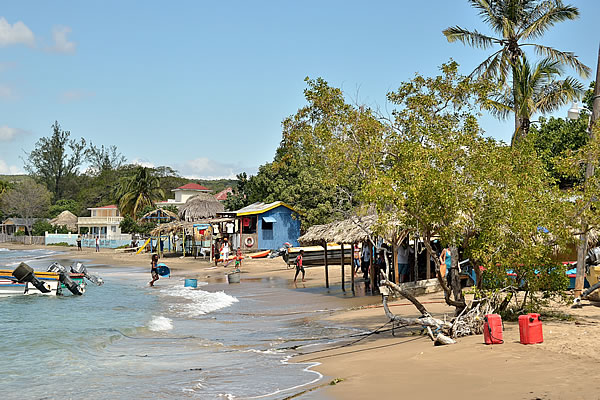 |
|
A typical Jamaican beach with shacks: Treasure Beach |
|
The food is another cost that you have to take into account. Backpackers who are willing to provide their own breakfast in the form of delicious tropical fruit or peanut porridge at small street stalls, will feel satisfied for about 1 to 2 US$. A popular alternative for lunch are the "Patties": a kind of large cheese soufflés filled with all sorts of savory fillings (beef, chicken, vegetables, shrimps), which are often eaten with coco bread (a kind of light, slightly sweet white bread). A shrimp patty with coco bread is delicious and costs J$ 215 (1.87 US$). For the evening meal you can look for little restaurants where huge meals are served in Styrofoam trays. For J$ 500 (4.34 US$) you eat yourself completely full with a large and delicious dish with traditional grilled jerk chicken or goat curry with rice, red beans and white cabbage salad. Even more hungry? Grab a tasty soup at for J$ 120 (US$ 1.04). If you prefer the more expensive (tourist) restaurants, costs rise quickly. That is also the case if you want to try the famous Blue Mountain Coffee on a nice location; a cup of coffee for J$ 500 (4.34 US$) is not an exception. A traveler who has a tight budget should always ask the price first; because if things are not priced in Jamaica, the price is often more expensive than expected. The price of one typical product that backpackers always want to know, is beer. A bottle of the popular Jamaican Red Stripe beer tastes fine and costs between J$ 130 (1.13 US$) in the supermarket and J$ 250 (2.17 US$) in a bar. Water is almost everywhere drinkable from the tap. |
|
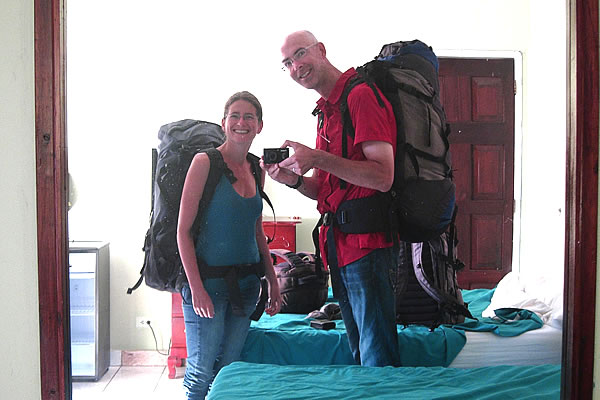 |
|
Ready for the bus ride from Montego Bay to Black River |
|
Transportation in Jamaica is affordable. Public transport is divided into the luxury Knutsford buses and the "regular" public transport. Knutsford buses connect major cities with comfortable big coaches, but the costs are about three times higher than the ordinary public transport, which consists of minibuses and route taxis. Minibuses are small in size but big in loading capacity. With small wooden planks, additional seats are created in the aisle. This form of transport is not comfortable, but it is the way most Jamaicans travel. Jamaicans love to chat and discuss, so taking a public bus is a great way to get in touch with them. To give you an example of the prizes: the two-hour ride from Port Antonio to Kingston is 95 kilometers and costs J$ 450 (3.91 US$) per person. If you have a big backpack, you have to pay for one additional seat because there is often no place outside the seats. The minibuses usually only leave when they are completely full. The same is true for route taxis: cars that travel a fixed route. Besides the driver, one other person sits in the front, while four other passengers share the back seat. Whether you share the backseat with thick or thin people: it is the responsibility for the passengers to make it fit. One of the most variable costs are the entrance fees of attractions. Although the average annual income of Jamaicans is just US$ 4,500, there are very expensive attractions in Jamaica. If your holiday is only successful after visiting the theme park “Mystic Mountain” in Ocho Rios, be ready to spend US$ 139 for an entrance ticket; the Bob Marley Museum in Kingston costs J$ 2000 (US$ 17.40) and a magnificent waterfall cost between US$ 10 and US $20 per person. That’s not cheap! In our opinion, shoestring backpackers can travel in Jamaica, if they want to share a double room, for around 40 US$ per person per day. This is approximately US$ 25 per person for a twin room, plus US$ 7.5 for food, US$ 2.5 for transportation and an additional US$ 5 for other expenses such as ice creams, drinks, etc. Entrance fees are additional. With this kind of pricing, Jamaica is still much more expensive than the real backpacker’s destinations in Southeast Asia and Central / South America. But if you want to experience the land of Reggae, rum, Bob Marley and the fastest man on earth (Usain Bolt), this is what you need to take into account. |
|
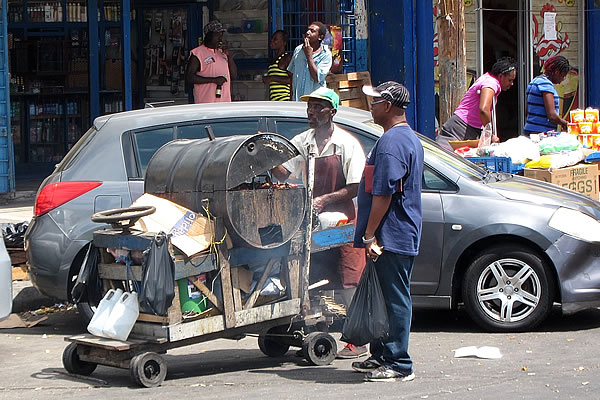 |
|
A Jerk street seller in downtown Kingston |
|
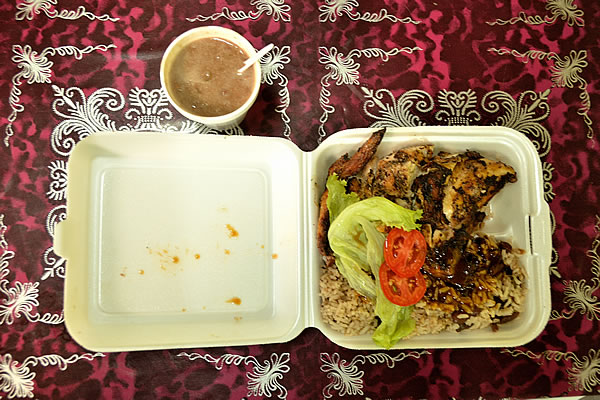 |
|
A local meal: Chicken Jerk with rice and brown beans, and a red peas soup |
|
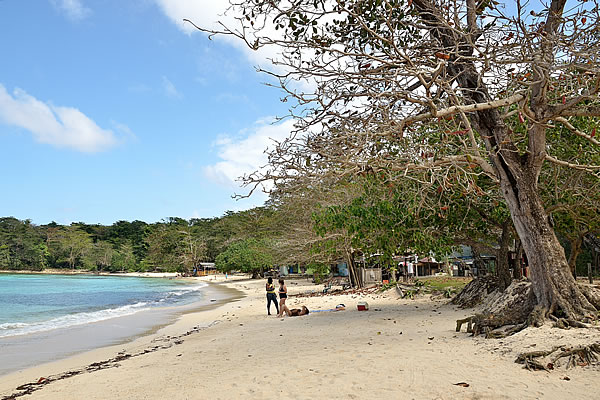 |
|
The beautiful beach of Winnifred near Port Antonio |
|
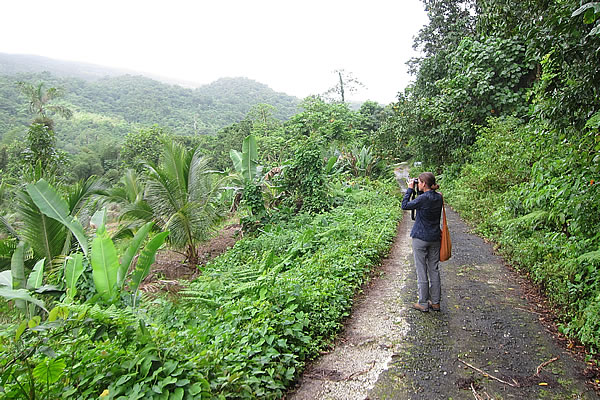 |
|
Birdwatching on Ecclesdown Road |
|
 |
|
View from our room on the Bay of Manchioneal at Zion Country Resort © copyright - Babakoto.eu / 2015 |
|